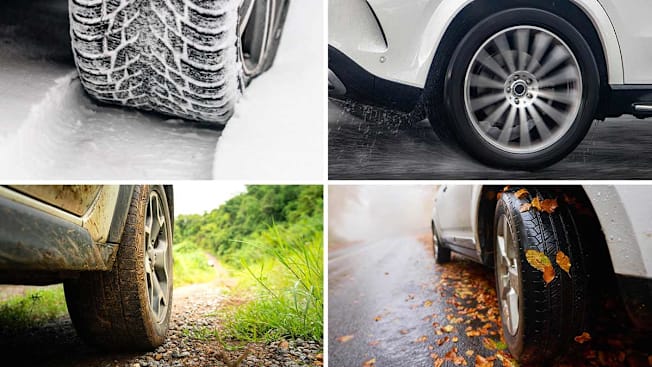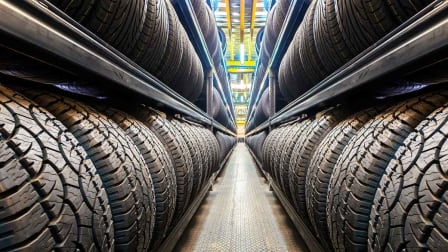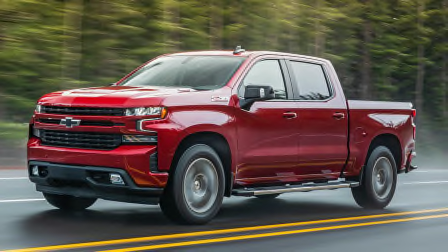The Driving Forces Behind Tire Purchases Revealed
CR's exclusive new survey reveals insights about tire purchases, including the rising popularity of online shopping and the demand for durability and fuel efficiency

Tires may all look the same, but just as there can be significant differences in their performance, there can be variations in the tire-buying experience. A new Consumer Reports survey reveals what truly matters to drivers when buying tires, sharing their performance priorities, satisfaction with the retail experience, and money-saving tips.
Combined with our tire testers’ expertise, we’re able to provide data-driven insights to help you make an informed decision and choose the best tires for your vehicle and your driving style.
Top Pick Tires: Best Car, SUV, and Truck Tires
CR’s testing reveals the top tires for each type of vehicle.
What Drives Tire Purchases
Most buyers (64 percent) replaced their tire sets when their current tires were worn, and the second most common reason was premature or irregular wear (14 percent). A flat tire led to 9 percent of purchases, and a similar percentage cited performance problems (9 percent) and wanting a different type of tire (8 percent).
When it came time to buy, 85 percent bought all-season tires. Among those, 13 percent were all-weather tires. All-weather tires are enhanced all-season tires, with greater cold-weather capability. These split the difference between all-seasons and winter/snow tires, with the benefit of not needing to be removed come spring.
In choosing their next tires, CR members prioritized wet grip (74 percent), handling (73 percent), treadwear (66 percent), and ride comfort (57 percent). Even facing significant costs, these shoppers clearly focused on performance factors over price, which was considered very important to just 38 percent of survey respondents. Appearance and sustainable materials were the least important factors.
These priorities align with how our testers look at tire value as being the nexus of price, performance, and longevity.
“It is great to see consumers emphasize the safety-related performance factors when choosing a tire,” says Ryan Pszczolkowski, tire program manager at Consumer Reports. “This matches well with how we weight test results in calculating the Overall Score.”
Gordon Gingras, a CR tire technician, cautions that casual shoppers walking into a tire shop without doing their research in advance may be subject to marketing and sales staff recommendations that can steer them toward profitable models rather than the ones best suited for their priorities. “Taking just a couple of minutes to check our tire ratings can bring years of satisfaction,” he says. To do this, CR members can enter the year, make, and model of their vehicle, or browse the ratings based on tire type. Either path is a quick way to find the top-performing tires.
Importance of Tire Factors for Next Purchase
| Factor | Very Important % |
| Wet grip | 74 |
| Handling | 73 |
| Treadwear | 66 |
| Ride comfort | 57 |
| Noise | 48 |
| Winter grip | 47 |
| Price | 38 |
| Fuel efficiency/EV range | 35 |
| Same brand | 23 |
| Sustainable materials | 12 |
| Appearance | 9 |
Which Tires They Buy
Brand loyalty isn’t a significant factor among CR members when it comes time to buy replacement tires. In fact, just 23 percent said it was a very important consideration.
“It is possible to upgrade performance by choosing a different model that came on the car from the factory,” Pszczolkowski says. “But without doing your research, it is also possible that the replacement may not hold the road as well.” He adds that sticking with the original equipment tires is simplest, though different replacement tires can often provide longer tread life and better all-weather grip because the automakers typically emphasize fuel economy and ride comfort with their tire choices. “Being flexible with your tire choice does often mean you can improve performance, value, or even both.”
Members paid an estimated price of $212 per tire, down slightly from our previous survey, when the median price was $223. The median cost for installation remained unchanged for those who paid for that service, at $31.
How to Choose the Right Tire
When you hit that 4/32nds point, start looking at our ratings. The owner’s manual can confirm the right tire type and size. This is important for those who bought their car used because it might not have the correct tires installed. The model names and marketing claims can make it all seem confusing, so it helps to focus first on choosing the specific type of tire you need.
All-season tires are general-purpose, suitable for most driving conditions. There are versions made for cars, SUVs, and trucks.
All-terrain tires are popular for off-road-oriented vehicles. These tires look tough, with blocky tread, but they typically compromise wet handling, noise, and treadwear for off-road traction.
Ultra-high performance (UHP) tires give sports cars and some sedans and SUVs greater grip for enthusiastic driving.
Winter/snow tires provide the ultimate in cold-weather performance and are designed to be used only in cold conditions. They’re ideal for drivers who traverse snowy roads but an expensive inconvenience for drivers who can stay in until the streets get plowed.
All-weather tires are enhanced all-season tires, with greater cold-weather capability. These split the difference between all-seasons and winter/snow tires, with the benefit of not needing to be removed come spring.
EV tires are designed to balance weight and efficiency needs specific to electric vehicles.
Where They Buy Tires
People have many choices for where they buy their tires. Members in our survey provided enough data to rate 30 retail chains, spread across major tire retailer chains such as Discount Tire, wholesale clubs such as Costco, online retailers such as Tire Rack, and general automotive stores such as Pep Boys. Independent tire shops and car dealerships were also rated as two separate groups.
About one-fifth of surveyed CR members (22 percent) said they bought or installed their tires from independently owned tire stores, including local mechanics and service stations; 15 percent purchased and/or had their tires installed at car dealerships. Among the retail chains, Costco took the top spot, capturing 17 percent of tire purchases and/or installations, followed by Discount Tire/Tire Rack at 14 percent. No other retailer had a market share of 4 percent or more.
Satisfaction With Tire Buying
From the survey, we’ve ranked the retailers based on satisfaction, with insights on many factors such as sales staff, installation quality, waiting area, checkout ease, and costs. Les Schwab Tire Centers, independent retailers, Point S Tire, and Discount Tire/Tire Rack were the top five retailers in our overall satisfaction ratings, but only Les Schwab was rated in the top tier.
While no retailer earned our top mark for all the factors in the survey, more than half received favorable or very favorable overall satisfaction ratings. More than half (54 percent) of surveyed members were completely satisfied with their tire purchase experience, and 57 percent were completely satisfied. But there are differences among retailers in overall satisfaction, meaning that shoppers would be wise to consider the retailer ratings when choosing where to purchase their tires.
Overall, 17 percent of CR members ordered their tires online and had them shipped to a local store. Only 4 percent had the tires shipped home.
See our complete tire retailer ratings.
Tire Shopping Advice
Start researching replacement tires before you need them, when the tread depth is at 4/32 of an inch. Your local mechanic can advise you during routine services, or you can measure at home, checking the tread depth at three spots across the tire width to account for potential uneven wear.
To check tire wear—both when testing tires and with our personal cars—Consumer Reports experts use a $5 tread depth gauge you can buy online or at an auto parts store. You can also use an upside-down quarter: If the top of Washington’s head is visible, it’s time to order a replacement. But a tread depth tool with a simple color system—green, yellow, red, in most cases—is much easier to read, especially in a dark wheel well.
Traction is significantly compromised at 4/32 on an inch, particularly the ability to resist hydroplaning.
Watch for rebates from tire makers. Aside from winter/snow tires, our experts have found that tire pricing tends to be fairly consistent throughout the year. But having a little flexibility on timing helps in finding sales and rebates. Tire makers offer rebates so frequently that if one isn’t available this month, it may be featured next month on their websites. Rebates are typically $60 to $100 off a set of four tires.
Try negotiating the price at your local store. Call at least a couple of stores for prices and availability, and be sure to haggle on the price. Among the CR members who did, more than half were successful. Among those, the median savings was $37, with more than half saving at least $100.
Seek free perks. Most members (82 percent) who purchased or installed tires at a retailer received at least one free perk or service. Among all members in our surveys, about half got free tire rotation (47 percent) or free tire balancing (47 percent). Less common were free tire mounting (43 percent), free tire checks (31 percent), and free flat tire repairs (31 percent). These can save significant money over time. Tire rotations, for example, should be done every 5,000 to 7,5000 miles, and they typically cost about $60. Over 50,000, 60,000, 70,000 miles or more, that can mean big savings. And survey respondents who paid for installation spent about $19 to $31 per tire, meaning that perk can equal a one-time savings of $72 to $124.




















